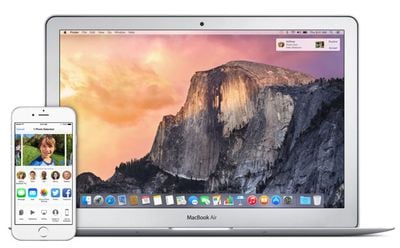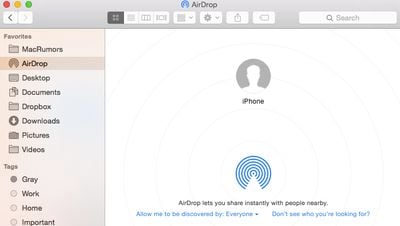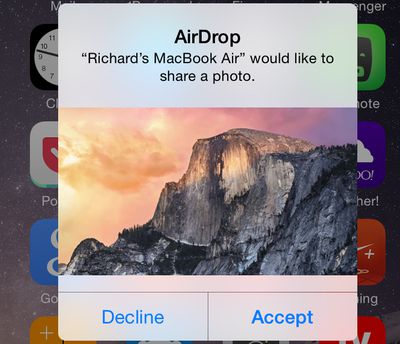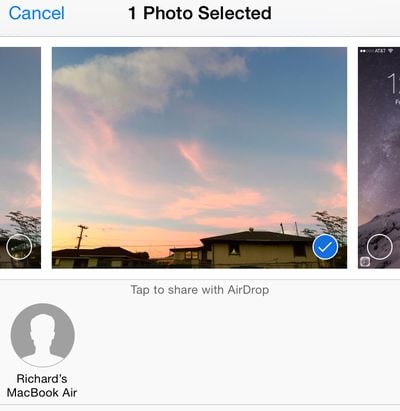How To Airdrop From Computer To Iphone
Apple's AirDrop file-sharing feature debuted with the release of OS X Lion and allowed users to transfer files from one Mac to another without using email or an external storage device. The feature made its way to iOS devices with the release of iOS 7, and offered a simple way for users to share files like photos between iOS devices. Now, with the release OS X Yosemite, users can use AirDrop to transfer files between the Mac and an iOS device for the first time.
This video shows you how it works:
Prior to the release of OS X Yosemite, users looking to transfer files between a Mac and iOS device usually had to resort to a third-party service like Dropbox or use an iCloud-connected app like Messages. AirDrop on OS X Yosemite and iOS 8 provides an easy-to-use solution for transferring files, as users can either drag and drop files from the Mac to iOS or move files from iOS to the Mac using the Share feature.
On the Mac, a number of apps like Safari, Preview, Pages, and Contacts support the Share feature. Third-party Mac apps like Deliveries, Ember, and Notability also feature Share support, allowing content to be transferred via AirDrop. On iOS, most of Apple's stock apps including Photos, Safari, Notes, and Maps feature Share support. Third-party apps including Camera+, Evernote, and eBay also support the feature.
Before you Start
You will need iOS 7 or later and OS X Yosemite in order to use AirDrop to transfer files between a Mac and an iOS device. Using AirDrop to move files between iOS and Mac is supported by all Mac models released in 2012 and later running OS X Yosemite. You can confirm that your Mac is compatible with AirDrop by clicking the Finder icon in the Dock and clicking the "Go" icon in the Menu Bar. If AirDrop is not listed as an option, then your Mac is not compatible with the feature. AirDrop between a Mac and an iOS device also requires an iPhone 5 or later, iPad 4 or later, iPad mini, or fifth-generation iPod touch.

Apple notes that AirDrop users should ensure that devices being used are within 30 feet of each other. If you have a firewall enabled on your Mac, navigate to Menu Bar -> Apple -> System Preferences -> General -> Security & Privacy -> Firewall -> Firewall Options and ensure that "Block all incoming connections" is not checked.
Keep in mind that it is not required for both devices to log into the same iCloud account to use AirDrop, but doing so offers the benefit of transferring files through AirDrop automatically without the need to approve each transfer. Files transferred between devices logged into different iCloud accounts will need permission to accept file transfers. Both iOS devices and Macs must be powered on and not locked in order to make AirDrop file transfers.
Steps
1. Turn on Wi-Fi on your iPhone (Settings -> Wi-Fi) and Mac (Menu Bar -> Wi-Fi -> Turn Wi-Fi On. AirDrop will still work between the Mac and an iOS device even if both are using different Wi-Fi networks.
2. Turn on Bluetooth on your iPhone (Settings -> Bluetooth) and Mac (Menu Bar -> Apple -> System Preferences -> Bluetooth -> Turn Bluetooth On).
3. Turn on AirDrop on your iPhone (Slide up to access Control Center -> AirDrop -> Choose "Contacts Only" or "Everyone") and Mac (Finder -> Menu Bar -> Go -> AirDrop -> Click "Allow me to be discovered by:" -> Choose "Contacts Only" or "Everyone").

4. You may now begin using AirDrop to transfer files between a Mac and an iOS device. To test it out, go to the AirDrop menu in Finder and notice that your iOS device is represented by circle. Drag and drop a file onto the circle, and your iOS device will prompt you to accept the file.

You can also transfer files from the Mac to an iOS device using apps that have Share feature built-in. The Share menu can be accessed in the upper right corner of an app and is represented by a square with an upward facing arrow.
![]()
The iOS share icon (middle) as seen in Safari
Selecting the AirDrop option from the Share menu brings up a list of devices that can receive files.

5. Transferring a file from an iOS device to the Mac can be done in any app that supports the Share functionality. Like on the Mac, the Share button brings up a list of options for transfers including AirDrop. For example, sending an image to the Mac from the Photos app can be done by tapping the Share button, tapping AirDrop, and selecting the desired Mac. A prompt to accept the file should then appear on the Mac.

Troubleshooting
Some users have had trouble with AirDrop functionality between the Mac and iOS devices since it launched with OS X Yosemite. Members on our forums and on Apple's support forums have reported that restarting both devices fixed their problems. If the devices aren't recognizing each other, make sure AirDrop is set to "Everyone" instead of "Contacts Only," as the latter setting has caused some problems for users. A number of users have also realized their Macs are too old to support AirDrop functionality between OS X and iOS after attempting to try out the feature, so ensure that your Mac is a 2012 model or newer by going to Menu Bar -> Apple -> About This Mac.
Related Stories
HYPER Debuts 15-Port Dock That Supports 3 4K Displays
Monday November 15, 2021 10:02 am PST by Juli Clover
HYPER today announced the launch of its latest dock, a 15-port version that is designed for the 13, 14, 15 and 16-inch MacBook Pro models. The HyperDrive 4K Multi-Display Docking Station supports up to three 4K displays on larger Mac machines. There are three HDMI ports and three DisplayPorts, all of which support 4K displays at up to 60Hz, along with a Gigabit Ethernet port, a 100W USB-C PD ...
Apple Updates AirPods Pro Firmware to Version 4A402 and AirPods 3 Firmware to 4B66
Tuesday November 16, 2021 11:34 am PST by Juli Clover
Apple today released a new 4A402 firmware update for the AirPods Pro, which is up from the prior 4A400 firmware that was released back in October. Apple has also updated the AirPods 3 firmware to 4B66, up from the 4B61 that was previously available. Apple does not offer information on what's included in refreshed firmware updates for the AirPods, so we don't know what improvements or bug ...
Top Stories: Tim Cook on Sideloading, iOS 15.2 Features, Apple Silicon Roadmap, and More
Apple is continuing to work on its next set of operating system updates, and the new beta of iOS 15.2 seeded to developers and public beta testers this week includes a number of tweaks and improvements. Tim Cook also spoke at this week's DealBook online summit, addressing some of the recent controversy about whether Apple should be required to allow "sideloading" of apps from outside the App ...
Amazon Launches Prime Video App for Mac
Monday November 15, 2021 9:05 am PST by Juli Clover
Amazon today introduced a native macOS app for its Amazon Prime Video service, with the app now available from the Mac App Store. Prime Video subscribers can stream content using the new app, or download content on Macs for offline viewing. All Amazon Prime content is available through the Mac app. Picture-in-Picture and AirPlay are both supported features that work with Amazon's new app, ...
Apple Imposing Strict Terms on U.S. States for Digital IDs in Wallet App
Apple's agreement with U.S. states looking to add digital ID cards such as driver's licenses to the Wallet app includes strict terms and charges footed to the taxpayer, according to fintech consultant Jason Mikula and CNBC. The ability to add a driver's license or ID to the Wallet app is a new feature in iOS 15. Customers will be able to tap the plus icon at the top of the Wallet app to add...
How To Airdrop From Computer To Iphone
Source: https://www.macrumors.com/2014/10/29/how-to-share-files-mac-ios-airdrop/
Posted by: foxsaisuatecous.blogspot.com

0 Response to "How To Airdrop From Computer To Iphone"
Post a Comment